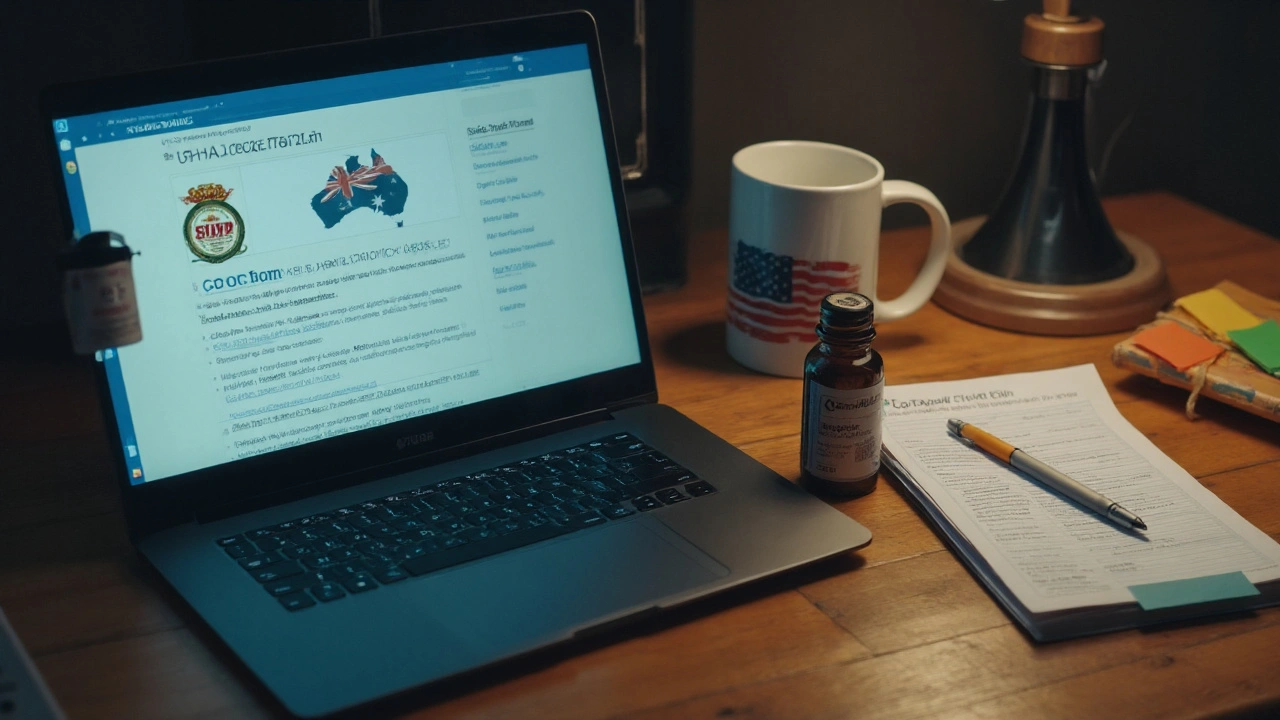![Capoten (Captopril): Official Info, Uses, Dosage, Side Effects, Warnings [2025]](/uploads/2025/08/capoten-captopril-official-info-uses-dosage-side-effects-warnings.webp)
Searching for Capoten usually means you want the official label fast, a plain-English summary of what it does, and the safety checks that stop people getting into trouble. You’ll get all three here. I’ll show you the shortest path to the official documents (Australia and US), then the practical stuff: when it’s used, how to take it, what to look out for, and the lab checks that matter. Expect clear steps, up-to-date Australian context, and no fluff.
Get to the official Capoten info fast (Australia & US)
If your goal is the official, regulator-approved wording-indications, dosing, contraindications-go here first. These are the documents doctors, pharmacists, and hospitals trust.
Australia (TGA) - Product Information (PI) and Consumer Medicine Information (CMI)
- Open your browser and go to the Therapeutic Goods Administration website (TGA).
- Use the site search bar. Type: “captopril PI” or “Capoten PI”.
- In results, look for “Product Information” (PI) PDFs. The PI is the detailed, prescriber-level document. The “Consumer Medicine Information” (CMI) is the patient-friendly version.
- Download the latest version (check the date in the header-use the most recent update).
Tip: If you can’t find Capoten by brand, search “captopril” (the active ingredient). Brands shift over time; the active ingredient search always works.
US (FDA/DailyMed) - Prescribing Information
- Go to DailyMed (the US government’s official label library).
- Search “Capoten” or “captopril”.
- Open the most recent “Prescribing Information” (full label). Check the revision date.
Why both? The core science is the same, but wording and indications can vary by region. If you’re in Australia, stick with the TGA PI as your primary source. If you want additional depth (like US-specific warnings), DailyMed is useful.
Australia pricing/availability check
- Go to the PBS website (Pharmaceutical Benefits Scheme).
- Search “captopril”.
- Confirm strengths on the PBS (usually 12.5 mg, 25 mg, 50 mg tablets). PBS listing means your pharmacy price is capped at the standard co-payment (lower for concession cards).
Also handy: NPS MedicineWise or Healthdirect for a plain-English patient overview. Search “captopril” there if you want a quick consumer summary written for Australians.
What Capoten is used for and how it works
Capoten is the brand name for captopril, an ACE inhibitor. It lowers blood pressure, protects the heart after a heart attack, and slows certain kinds of kidney damage. It’s been around for decades, and even with newer drugs out, it still earns a place when a short-acting ACE inhibitor is preferred or when clinicians need flexible dose titration.
Main uses (Australia/US common ground)
- Hypertension (high blood pressure), as a single drug or with other agents.
- Heart failure, usually alongside a diuretic and often a beta blocker, with careful titration.
- Post-myocardial infarction (post-MI) in stable patients to improve survival and reduce remodeling.
- Diabetic nephropathy in type 1 diabetes with proteinuria, to slow kidney decline.
Depending on your region’s label, there may be extra or slightly different wording around heart failure and post-MI timing. That’s why checking the local PI matters.
How it works, in human terms
Captopril blocks ACE (angiotensin-converting enzyme). Less ACE means less angiotensin II (a vessel-tightening hormone) and less aldosterone (which tells your body to hold salt and water). The net effect: blood vessels relax, blood pressure drops, the heart pumps against less resistance, and the kidneys are protected from pressure-related damage. It can raise potassium a bit and nudge up creatinine at the start-more on that in the safety section.
Why captopril specifically?
- Short half-life: Good for careful, stepwise titration and for situations where clinicians want effects to wear off quickly if needed.
- Taken 2-3 times daily: Not as convenient as once-daily ACE inhibitors like perindopril or ramipril, but sometimes the fast on/off is the point.
- Food effect: Absorption drops with food, so timing matters more than with some other ACE inhibitors.

Dosing at a glance and how to take it
Don’t self-start, adjust, or stop captopril without your doctor’s guidance. The numbers below are standard, but your dose depends on your blood pressure, kidney function, other meds, and how you feel on it.
General rules of thumb
- Take it 1 hour before meals. Food reduces absorption.
- Start low, go slow-especially if you’re on a diuretic, have kidney disease, or are older.
- Expect 2-3 doses a day because of the short half-life.
Typical starting and target doses (adults)
- Hypertension: Start 12.5-25 mg twice daily; usual range 25-50 mg two to three times daily. Many land around 50 mg twice daily. Maximum total daily dose often 150 mg (check PI).
- Heart failure: Start 6.25-12.5 mg two to three times daily; titrate every 1-2 weeks toward 25-50 mg three times daily as tolerated.
- Post-MI (stable patients): Low starting doses (e.g., 6.25 mg), then slowly up; specifics vary-follow your cardiologist’s plan and the PI.
- Diabetic nephropathy: Doses similar to hypertension, targeted to blood pressure and renal protection goals.
Renal adjustment
Captopril is cleared by the kidneys. If your eGFR is reduced, your doctor may lower the dose or extend the dosing interval. Severe renal impairment calls for conservative dosing and tight monitoring of potassium and creatinine.
When you’ll feel it
- Onset: BP lowering starts in about 30-60 minutes.
- Peak effect: Around 1-2 hours after a dose.
- Duration: Short-hence multiple daily dosing.
| Fast fact | Typical value/summary | Why it matters |
|---|---|---|
| Bioavailability | ~60-75% fasting; reduced with food | Take 1 hour before meals for consistent effect. |
| Time to peak | ~1-2 hours | Helps time BP checks after dose changes. |
| Half-life | ~2 hours | Explains why most regimens are BID or TID. |
| Elimination | Renal | Dose adjustments and lab monitoring if kidney function is down. |
| Max daily dose (adult) | Commonly cited up to 150 mg/day | Check your region’s PI for the exact cap. |
Practical dosing tips
- Split timing: breakfast, mid-afternoon, and evening (1 hour before meals). If BID works for your numbers, morning and mid-evening is common.
- On a diuretic (like hydrochlorothiazide or furosemide)? Your clinician might pause or reduce it before starting captopril to lower the fainting risk.
- Don’t double up if you miss a dose. Take the next one when due.
Safety first: warnings, interactions, and lab checks
ACE inhibitors save lives, but they also come with clear red lines. Respect these and you’ll avoid most headaches.
Do not use if
- You are pregnant or planning pregnancy. ACE inhibitors can seriously harm a fetus (especially in the second and third trimesters). Use reliable contraception while on therapy.
- You’ve ever had angioedema (swelling of the face, lips, tongue) with any ACE inhibitor.
- Known bilateral renal artery stenosis-risk of kidney failure rises sharply.
Use with extreme caution
- Severe aortic stenosis (fixed outflow obstruction): dropping afterload can cause collapse.
- Advanced kidney disease: you can still use captopril, but doses are lower and labs are frequent.
- Volume depletion (vomiting, diarrhea, aggressive diuresis): rehydrate first to avoid an abrupt creatinine rise.
Common side effects
- Dry, persistent cough (from bradykinin). Annoying but harmless; it goes away after stopping.
- Dizziness or lightheadedness, especially after the first few doses or dose increases.
- Changes in taste (dysgeusia)-more unique to captopril than some other ACE inhibitors.
Serious but less common
- Angioedema (swollen lips/tongue/throat). This can be life-threatening. Seek urgent care.
- High potassium (hyperkalemia): muscle weakness, palpitations; picked up by blood tests.
- Kidney function drop: typically small and acceptable, but large jumps require action.
Drug and food interactions to respect
- Potassium-sparing diuretics (spironolactone, eplerenone, amiloride) and potassium supplements: risk of high potassium. Avoid salt substitutes containing potassium chloride unless your doctor says it’s okay.
- NSAIDs (ibuprofen, naproxen, diclofenac): the ACE inhibitor + NSAID + diuretic combo can crash kidney function. Use paracetamol where possible and talk to your clinician.
- Lithium: ACE inhibitors can raise lithium levels-monitor or avoid together.
- Aliskiren: avoid in diabetes (labelled contraindication in many regions).
- Sacubitril/valsartan (ARNI): do not overlap. Leave a 36-hour washout when switching to avoid angioedema risk.
- Dialysis with high-flux membranes or LDL apheresis using dextran sulfate: rare anaphylactoid reactions have been reported-alert dialysis staff.
- Alcohol: can boost blood pressure lowering; go easy until you know your response.
What lab changes are acceptable?
- Creatinine: A rise up to about 30% from your baseline (or eGFR drop up to ~25%) within the first couple of weeks can be acceptable. Bigger jumps need a check for dehydration, renal artery stenosis, or drug interactions (NSAIDs).
- Potassium: Keep it below ~5.5 mmol/L. Closer monitoring if you’re on spironolactone/eplerenone.
When to check labs
- Before starting (baseline potassium and creatinine/eGFR).
- 1-2 weeks after starting or after each dose increase.
- After illness causing dehydration, or if adding interacting drugs.
Pregnancy and breastfeeding
- Pregnancy: No. If pregnancy occurs, stop and call your doctor promptly so they can switch you safely.
- Breastfeeding: Small amounts of captopril pass into milk. Many references (e.g., LactMed) consider low-dose captopril compatible with breastfeeding, especially in older infants, but the decision is individual-check with your doctor or pharmacist.
Sources behind this advice
The points above reflect regulator-approved labels (TGA Product Information; FDA Prescribing Information via DailyMed) and Australian references like the Australian Medicines Handbook and Therapeutic Guidelines: Cardiovascular. Those are the gold standard sources clinicians use in practice.

FAQ, quick checklists, and next steps
Sometimes you don’t need a lecture-just the answer. Here are the most common things people ask (and what to do next).
Is Capoten the same as captopril?
Yes. Capoten is a brand; the active ingredient is captopril. Pharmacy shelves in Australia often carry generic captopril with the same active ingredient and dose.
Is Capoten still available in Australia?
Captopril tablets are available and PBS-listed in multiple strengths. Brand names may vary by supplier and time. If your pharmacy doesn’t stock your usual brand, they can dispense an equivalent captopril tablet with the same strength.
How fast will it lower my blood pressure?
You’ll usually see an effect in 30-60 minutes, with peak effect around 1-2 hours. That’s why doctors sometimes like it for careful titration.
Can I split the tablets?
Many captopril tablets are scored and can be split. Ask your pharmacist to confirm for the specific brand you receive.
What if I miss a dose?
Skip the missed dose and take the next one at your regular time. Don’t double up.
What if I get a dry cough?
Common with ACE inhibitors. If it’s mild, your doctor might watch and wait. If it’s driving you mad, flag it-some people switch to an ARB (e.g., candesartan) if appropriate.
What if my potassium is high?
Your doctor may adjust your dose, tweak other meds (like spironolactone), or change your diet. Don’t start salt substitutes without explicit advice-they often contain potassium.
Can I drink alcohol on captopril?
Light drinking can exaggerate the BP-lowering effect. Go slow, see how you feel, and avoid heavy sessions.
How does captopril compare with other ACE inhibitors?
Mechanism is shared across the class. Captopril is shorter-acting and more sensitive to food; others like perindopril or ramipril are once-daily. Doctors often choose based on dosing convenience, past tolerance, kidney status, and guideline pathways.
Can I take it with ibuprofen?
Try not to. The ACE inhibitor + NSAID combo can push kidneys the wrong way, especially if you’re also on a diuretic. Paracetamol is usually kinder for pain. If you need an NSAID, talk to your doctor and check labs.
Will it affect sports or heat?
Hard training and hot weather can dehydrate you, which raises the risk of dizziness or kidney function wobble. Hydrate well and pause extreme efforts during dose changes.
What symptoms mean stop and get help?
- Swelling of lips, face, tongue, or trouble breathing (possible angioedema).
- Severe, persistent dizziness or fainting.
- Signs of high potassium (muscle weakness, palpitations).
Starting checklist (print this)
- Baseline labs done: potassium, creatinine/eGFR.
- Plan for repeat labs in 1-2 weeks after starting or changing dose.
- Check interacting meds: NSAIDs, lithium, potassium supplements, spironolactone/eplerenone, aliskiren.
- Set dose timing 1 hour before meals; use phone reminders.
- Have a blood pressure plan: what numbers to aim for, when to check, when to call.
Dose-titration cheat sheet (talk to your doctor)
- Increase every 1-2 weeks if BP is above target and you feel fine.
- Hold or reduce if you’re dizzy, dehydrated, or labs go off track.
- Max daily dose often 150 mg; exact ceiling per your PI and clinician.
Next steps based on your situation
- Newly prescribed: Book a lab check in 1-2 weeks. Set up dose reminders. Avoid NSAIDs.
- On it and feeling dizzy: Check blood pressure seated and standing; drink fluids; call your clinic-dose may need trimming or a diuretic tweak.
- Developed a cough: Non-urgent review. Many switch to an ARB if it’s disruptive.
- Planning pregnancy: Don’t wait-talk to your doctor now about switching.
- Kidney numbers jumped: Pause NSAIDs, rehydrate if dehydrated, and get a clinician review. They may reduce the dose or look for renal artery issues.
If you only came here for the label
- TGA website → search “captopril Product Information”.
- Open the most recent PI PDF; check the date.
- For a second opinion, DailyMed → search “Capoten” → open “Prescribing Information”.
Credible sources behind this guide
- TGA Product Information (Australia): the definitive label for captopril here.
- FDA Prescribing Information via DailyMed (US): thorough, frequently updated monographs.
- Australian Medicines Handbook (AMH, 2025): practical dosing and interaction details for clinicians.
- Therapeutic Guidelines: Cardiovascular (latest edition): evidence-backed treatment pathways used in Australian practice.
If you’re comparing brands, checking doses, or just making sure you’re taking it right, you’re covered now. If anything here clashes with your own PI or doctor’s plan, follow that-personal factors always win over general rules.
liam coughlan
Just took captopril for the first time last week. Dry cough already? Yep. Not fun, but at least my BP’s down. Took it on an empty stomach like the guide said - no issues with absorption. Still figuring out the 3x/day schedule, but phone alarms help.
Benjamin Gundermann
Look, I get it - ACE inhibitors are the OG hypertension drugs. But let’s be real, we’re still using a 1980s molecule because Big Pharma doesn’t want to fund better ones. Captopril’s half-life is a nightmare. You’re up at 2 a.m. taking pills like it’s a job. Meanwhile, in Europe they’ve got once-daily options that don’t make you feel like a lab rat. And don’t even get me started on the food thing - you gotta time your meals like a nuclear physicist. We could’ve moved on. We didn’t. Because bureaucracy.
Rachelle Baxter
Ugh. So many people miss the point. 🙄 Captopril is NOT safe in pregnancy - PERIOD. 🚫 If you’re even thinking about getting pregnant, STOP. And no, ‘I’ll just stop it when I find out’ is not a plan. That’s how babies get kidney damage. 🤦♀️ Also - NSAIDs + ACEi + diuretic = renal failure waiting to happen. 📉 I’ve seen it. Don’t be that person. 🙏
Dirk Bradley
While the author presents a superficially coherent overview, one must acknowledge the inherent epistemological limitations of relying upon regulatory documents as epistemic authorities. The TGA and FDA, while ostensibly objective, are institutionally constrained by political and economic interests. One must therefore interrogate the underlying ideological frameworks that shape the ‘official’ prescribing information - particularly in the context of pharmaceutical capitalism. The notion that ‘the PI is the gold standard’ is, in fact, a discursive construct designed to naturalize corporate hegemony over clinical knowledge.
Emma Hanna
Wait - did you just say ‘check your region’s PI’? And then you didn’t link the actual TGA PDF? That’s irresponsible. You’re telling people to ‘search for it’ - but what if they’re not tech-savvy? What if they’re elderly? What if they’re in a rural area with no internet? You didn’t even provide the direct URL. This isn’t helpful - it’s negligent. 🚨
Mariam Kamish
They didn’t even mention the angioedema risk in the first paragraph. 😒 And now people are gonna take this stuff and die because ‘it’s just a cough’. Also, why is the FDA info buried? This feels like a drug company ad. 🤢
Manish Pandya
Used captopril in India for years. Cheap, effective. But people here don’t know about the food interaction - they take it with chapati and wonder why BP doesn’t drop. Also, potassium levels? Nobody checks. Just give the pill. Scary.
Kaylee Crosby
Biggest win? The checklist at the end. Printed it out and taped it to my fridge. Got my labs done, set reminders for doses, and told my partner to watch for swelling. This guide saved me from panic. Seriously - thank you. 🙌
Adesokan Ayodeji
Man, this is exactly what I needed. I’m from Nigeria and we don’t always get clear info on meds here. I showed this to my cousin who’s on captopril - he didn’t even know about the food thing. Now he takes it before breakfast and his BP is way better. Also, the potassium warning? He was eating those potassium-rich bananas like crazy. We’re gonna cut back now. This post is gold. 🙏❤️
Karen Ryan
Love how you included both US and AU info - as a Canadian who moved from the States, this helped me bridge the gap. Also, the PBS link? Genius. I didn’t even know Canada’s system was so different. 🇨🇦🇺🇸
Terry Bell
so like… captopril is kinda like the grumpy grandpa of blood pressure meds? old school, needs to be fed right, and kinda annoying but somehow still works? i mean, i get why docs still use it - it’s like having a hammer when you need to drive a nail. sure, there’s a nail gun, but sometimes you just need that ol’ reliable thing. also, food = bad? yeah i’ll just snack on air then 🤪
Lawrence Zawahri
EVERYONE KNOWS THE FDA IS COMPROMISED. They approved this drug in the 80s and now they’re hiding the real side effects. Angioedema? That’s not rare - it’s COVERED UP. And the cough? That’s your lungs screaming. They don’t want you to know how many people die from this. I’ve got the documents. I’ve got the whistleblower emails. You think this is about medicine? It’s about profit. 💀
Jack Riley
It’s funny how we treat captopril like it’s a magic bullet. We forget that ACE inhibition is just one tiny lever in a vast, chaotic biological machine. We reduce a person’s entire cardiovascular system to a single enzyme - and then wonder why outcomes vary. Maybe we’re not treating disease. Maybe we’re just trying to control the uncontrollable. And in that control, we lose the person.
Jacqueline Aslet
While the content is, on the surface, informative, the tone exhibits a troubling condescension toward the lay reader. The phrase ‘no fluff’ is particularly offensive - implying that clarity is synonymous with austerity. Furthermore, the reliance on institutional documents as the sole arbiters of truth reflects a dangerous epistemological hierarchy. One wonders: who authorized these documents? Who funded the trials? The answer, of course, is never stated.
Caroline Marchetta
Oh, so now we’re just supposed to ‘check your PI’? Like that’s gonna happen when you’re on a $1000 deductible and your insurance won’t cover the consult? And don’t even get me started on the ‘lab checks’ - you think I’ve got time to sit in a waiting room for 3 hours to get a potassium test? This guide is a luxury for people who don’t have to work 3 jobs to afford their meds. 🤡
Valérie Siébert
YESSSS this is the vibe!! 🙌 I’ve been on captopril for 2 years and the food thing? LIFE CHANGER. Took it with breakfast once - felt like a ghost for 3 hours. Now I’m like a ninja - 1 hour before, no snacks, no excuses. Also - potassium? My doc said 5.5 is the max but mine was 5.8 and I didn’t even know!! Got scared, called, fixed it. THANK YOU for the checklist!! 💪
katia dagenais
Let’s be honest - this whole post is just a marketing pamphlet dressed up as ‘practical advice’. The TGA? The FDA? They’re not neutral. They’re corporate puppets. And the ‘helpful expert’ tone? It’s gaslighting. You make people feel dumb for not knowing the PI. But who even reads those? The doctors? The pharmacists? Not the patients. And yet you act like we’re all supposed to be medical scholars. This isn’t helpful - it’s elitist.
Josh Gonzales
Just want to add - if you’re on dialysis and they use a high-flux membrane, tell the staff you’re on captopril. That anaphylactoid reaction thing? Real. Happened to my uncle. They didn’t know. He ended up in ICU. Don’t assume they know.
Patrick Goodall
They’re lying about the half-life. It’s not 2 hours. It’s 45 minutes. They’re hiding it because if people knew how fast it wears off they’d panic. And the ‘3x a day’ thing? That’s just so they can sell you more pills. I did a blood test every hour for 12 hours - the levels dropped faster than a TikTok trend. This whole thing is a scam.






Write a comment